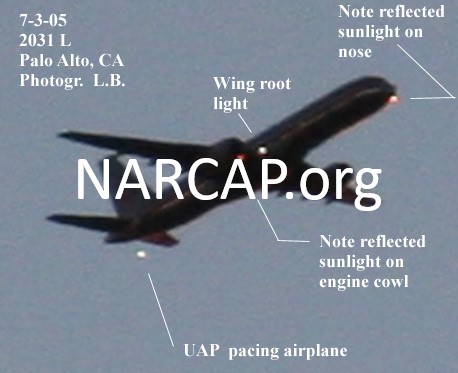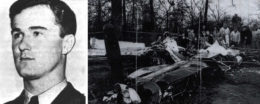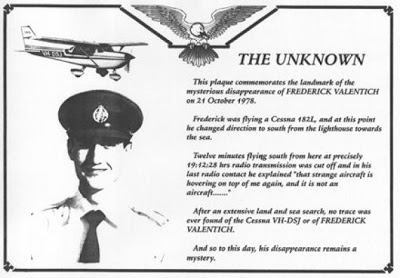by Charles Lear
 Because the F stands for “flying” in the acronym UFO, it stands to reason that pilots should frequently be UFO witnesses. They certainly are and there is even a specialized reporting center just for them. The National Aviation Reporting Center on Anomalous Phenomena was founded in 1999 by Dr. Richard M. Haines. The organization is dedicated to the study of Unidentified Aerial Phenomena and their effects on aviation safety. By the way, Dr. Haines finds the UFO designation for the phenomena so distasteful, he refuses to appear on Podcast UFO. Most pilots prefer to remain anonymous, as publicly admitting to seeing a flying saucer is not usually an enhancement to their careers.
Because the F stands for “flying” in the acronym UFO, it stands to reason that pilots should frequently be UFO witnesses. They certainly are and there is even a specialized reporting center just for them. The National Aviation Reporting Center on Anomalous Phenomena was founded in 1999 by Dr. Richard M. Haines. The organization is dedicated to the study of Unidentified Aerial Phenomena and their effects on aviation safety. By the way, Dr. Haines finds the UFO designation for the phenomena so distasteful, he refuses to appear on Podcast UFO. Most pilots prefer to remain anonymous, as publicly admitting to seeing a flying saucer is not usually an enhancement to their careers.
There are, however, sightings that have made national and international news, with the pilot’s name included. These go as far back as 1947 with the sighting by Kenneth Arnold and another that same year by his soon to be friend, E. J. Smith, along with his crew. But, sometimes, there are encounters where planes disappear from radar and pilot witnesses are not left behind to tell their tales.
When approaching this subject, it’s natural to begin with the Bermuda Triangle and the tragic Dec. 5, 1945 case of Flight 19. This involved five TBM Avenger Torpedo Bombers that took off on a training mission and never returned. Twenty-seven men were lost and never seen again. Though some have speculated that aliens were responsible, there is no record of the pilots reporting any UFOs. A more plausible explanation is that the leader became confused, lost trust in his compass and led his squadron far into the Atlantic where they ran out of fuel.
There is another triangle known as the Great Lakes Triangle that has claimed its share of victims. This was the area of a truly mysterious case involving a vanishing plane and a UFO seen on radar. Known as the ” Kinross Incident,” this event occurred over Lake Superior on Nov. 23, 1953. An unknown aircraft, traveling at 500 mph approximately 160 miles to the northwest, was spotted on radar at Kinross Air Force Base. At 2322 hours (11:22 p.m.) an F-89C all-weather jet interceptor was scrambled to intercept. There were two men onboard: the pilot, Lt. Felix Moncla, Jr., and the radar observer, Lt. Robert Wilson. The last radio contact was made at approximately 2352 by the radar station at Kinross. At 2355, the blips of the F-89C and the unknown merged and then faded from the screen. There was no further contact with the F-89C. An extensive search was made and no trace of the aircraft or its crew was found.
 Five years prior to this, there was the Mantell Incident, which involved Kentucky Air National Guard pilot, Thomas Mantell. Mantell was chasing a UFO and pursued it beyond an altitude of 25,000 feet where, according to the Air Force report, he likely succumbed to hypoxia (lack of oxygen) and lost consciousness. A witness reported seeing his plane fall to the earth in a spiral descent.
Five years prior to this, there was the Mantell Incident, which involved Kentucky Air National Guard pilot, Thomas Mantell. Mantell was chasing a UFO and pursued it beyond an altitude of 25,000 feet where, according to the Air Force report, he likely succumbed to hypoxia (lack of oxygen) and lost consciousness. A witness reported seeing his plane fall to the earth in a spiral descent.
 The case received national press coverage and the Air Force explanation, offered by J. Allen Hynek as a scientific consultant for Project Sign, was that Mantell had chased the planet Venus. Hynek, in 1952, rejected that explanation when he determined Venus was not bright enough at that time to have been seen. Project Sign was then Project Blue Book and its first director, Capt. Edward J. Ruppelt, was satisfied that Mantell had been chasing a U.S. Navy Skyhook weather balloon, which was metallic, 100 ft in diameter and classified at the time.
The case received national press coverage and the Air Force explanation, offered by J. Allen Hynek as a scientific consultant for Project Sign, was that Mantell had chased the planet Venus. Hynek, in 1952, rejected that explanation when he determined Venus was not bright enough at that time to have been seen. Project Sign was then Project Blue Book and its first director, Capt. Edward J. Ruppelt, was satisfied that Mantell had been chasing a U.S. Navy Skyhook weather balloon, which was metallic, 100 ft in diameter and classified at the time.
Neither explanation satisfied the press or the public and it may have been that the lesson learned from this case influenced the Air Force’s handling of the press after the Kinross Incident. This case received very little coverage and might have been forgotten were it not for Donald Keyhoe. Keyhoe wrote about the case in his 1955 book, “The Flying Saucer Conspiracy.”
The Air Force explanation, that still stands today, was that the UFO was a Royal Canadian Air Force C-47 transport plane and that some sort of interaction other than a collision caused the F-89C to crash. The Canadian government denied that any of its planes was involved in the incident.
In Sept. 2006, Francis Ridge of the National Investigations Committee on Aerial Phenomena, received an email that claimed there had been wreckage found of an F-89C on the bottom of Lake Superior. A company called, “The Great Lakes Dive Company” had supposedly spotted it and had a website where an “Adam Jimenez” hosted a forum to discuss the discovery. The story traveled throughout the UFO community and investigators looked into it.
Linda Moulton Howe interviewed Adam Jimenez on Coast to Coast AM radio on Sept. 22, 2006. In an Oct. 7, 2006 update on her website, earthfiles.com, she reports that the GLDC website is no longer functional and that Jimenez and his associate, Jim Bessette, would not return phone calls or emails. She had been told the company would be moving and not settled until Oct. and she speculates that this might be a reason. Making this unlikely, however, is the news that MUFON director James Carrion had been unable to find evidence of a company doing business in the state of Michigan under the name given.
A transcript of the Jimenez interview is included below the update and Jimenez presents some intriguing evidence. According to him, they were using a sonar array to look for two French Canadian minesweepers that had sunk off the Keweenaw Peninsula when the array developed problems and needed to be repaired. When they resumed, it was too late to continue looking for the minesweepers so they decided to try for the F-89C as they were close to its last known coordinates. An image of what looks like the plane is taken from the GLDC website as is another image that looks like a disk lying at the end of a wedge-shaped “slide mark.” As intriguing as this is, there are good arguments that this was a hoax, including the fact that Adam Jimenez seems to have never existed.
 A more recent case comes from Austrailia. It is known as the Valentich Disappearance and, as the name suggests, involves the disappearance of a young pilot named Frederick Valentich. On Oct. 21, 1978, Valentich was flying a Cessna 182 in the early evening near Cape Otway, southwest of Melbourne. He radioed Air Traffic Control in Melbourne to ask about traffic in the area below 5000 ft and was told there was none. He then reports that that there seems to be a large aircraft there with four landing lights. He says that it passed over him and that it “seems to be playing some sort of game.” He describes it as not being an aircraft, that it has a long shape and that “it has such speed.” It hovers over him as he “orbits” and he describes that it has a green light and is shiny and metallic. He describes it vanishing and then hovering over him again. He repeats that “it’s not an aircraft” and the transmission ends.
A more recent case comes from Austrailia. It is known as the Valentich Disappearance and, as the name suggests, involves the disappearance of a young pilot named Frederick Valentich. On Oct. 21, 1978, Valentich was flying a Cessna 182 in the early evening near Cape Otway, southwest of Melbourne. He radioed Air Traffic Control in Melbourne to ask about traffic in the area below 5000 ft and was told there was none. He then reports that that there seems to be a large aircraft there with four landing lights. He says that it passed over him and that it “seems to be playing some sort of game.” He describes it as not being an aircraft, that it has a long shape and that “it has such speed.” It hovers over him as he “orbits” and he describes that it has a green light and is shiny and metallic. He describes it vanishing and then hovering over him again. He repeats that “it’s not an aircraft” and the transmission ends.
The tower operator from Melbourn tells his story in a segment from The Unexplained Files. Flight Service Operator Stephen Robey reports that after the transmission ended, there was “clicking sound” that was “pulsing-sort of electronic.”
A search was conducted using two RAAF transport planes and nothing was found. It was assumed that Valentich had crashed into the ocean. The case was headline news the next day and witnesses came forward saying they’d seen unusual lights in the area. A plumber, Roy Manifold, presented pictures of what he claimed was an object that had come out of the water and flown away at high speed. The best of those is blurry and the object appears as a black amorphous cloud.
Valentich’s plane was never found and theories ranging from alien abduction to him faking his death have been floated but nothing has ever been proven conclusively. Richard Haines, along with Paul Norman of the Victorian UFO Research Society, wrote a paper, “Valentich Disappearance: New Evidence and a New Conclusion.” It was published in the Journal of Scientific Exploration, Vol. 14, No. 1, pp. 19-33, 2000. It includes testimony from three witnesses who claimed they saw an airplane in the area at the time of Valentich’s last transmission. They said that it descended “at a steep angle with a much larger object with green lights flying just above it.” The abstract concludes that the plane probably crashed southeast of Cape Marengo 3-12 miles from shore and that the reported object “remains to be identified.
Pilots and planes disappearing have fascinated the public since the disappearance of Amelia Earhart. Planes are quite small when compared to the vastness of Lake Superior or the ocean and could easily evade discovery for years or even forever. However, until they are discovered, a mystery is a mystery and certain cases will continue to generate theories and speculations, and aliens often get the blame.